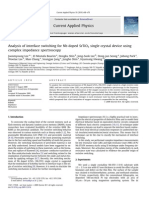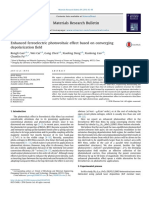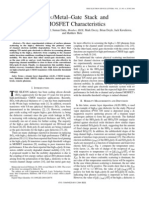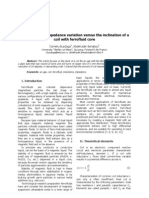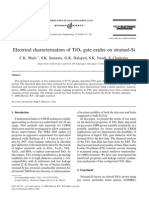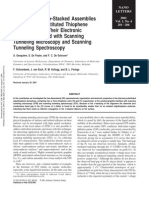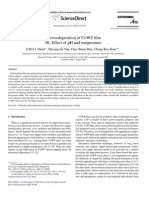Thin Solid Films: R.L. Gao, C.L. Fu, W. Cai, G. Chen, X.L. Deng, H.W. Yang, J.R. Sun, Y.G. Zhao, B.G. Shen
Thin Solid Films: R.L. Gao, C.L. Fu, W. Cai, G. Chen, X.L. Deng, H.W. Yang, J.R. Sun, Y.G. Zhao, B.G. Shen
Uploaded by
Bhabani Sankar SwainCopyright:
Available Formats
Thin Solid Films: R.L. Gao, C.L. Fu, W. Cai, G. Chen, X.L. Deng, H.W. Yang, J.R. Sun, Y.G. Zhao, B.G. Shen
Thin Solid Films: R.L. Gao, C.L. Fu, W. Cai, G. Chen, X.L. Deng, H.W. Yang, J.R. Sun, Y.G. Zhao, B.G. Shen
Uploaded by
Bhabani Sankar SwainOriginal Title
Copyright
Available Formats
Share this document
Did you find this document useful?
Is this content inappropriate?
Copyright:
Available Formats
Thin Solid Films: R.L. Gao, C.L. Fu, W. Cai, G. Chen, X.L. Deng, H.W. Yang, J.R. Sun, Y.G. Zhao, B.G. Shen
Thin Solid Films: R.L. Gao, C.L. Fu, W. Cai, G. Chen, X.L. Deng, H.W. Yang, J.R. Sun, Y.G. Zhao, B.G. Shen
Uploaded by
Bhabani Sankar SwainCopyright:
Available Formats
Thin Solid Films 583 (2015) 1318
Contents lists available at ScienceDirect
Thin Solid Films
journal homepage: www.elsevier.com/locate/tsf
Mechanism of ferroelectric resistive switching in Bi0.9La0.1FeO3 thin lms
R.L. Gao a,b,, C.L. Fu a, W. Cai a, G. Chen a, X.L. Deng a, H.W. Yang b, J.R. Sun b, Y.G. Zhao c, B.G. Shen b
a
b
c
School of Metallurgy and Materials Engineering, Chongqing University of Science and Technology, Chongqing 401331, China
Beijing National Laboratory for Condensed Matter Physics, Institute of Physics, Chinese Academy of Science, Beijing 100190, China
Department of Physics, State Key Laboratory of Low-Dimensional Quantum Physics, Tsinghua University, Beijing 100084, China
a r t i c l e
i n f o
Article history:
Received 24 April 2014
Received in revised form 17 March 2015
Accepted 18 March 2015
Available online 27 March 2015
Keywords:
Switching mechanism
Resistive switching
Bismuth lanthanum ferrite
Thin lms
Pulsed laser deposition
a b s t r a c t
Resistive switching devices are considered as one of the most promising candidates for the next generation memories and nonvolatile logic applications. In this paper, we report an anomalous resistive switching effect in BiFeO3
based hetero-structures. Different from conventional resistive switching devices made of metal oxides, no
forming process is needed to obtain a stable resistive switching effect in the ferroelectric resistive switching devices. Both positive and negative current peaks are observed under forward bias and reverse bias, respectively,
suggesting that exible Schottky-like barriers and conductive channels form at the top and bottom interfaces,
which play important roles in the resistive switching of Ag/Bi0.9La0.1FeO3/La0.3Sr0.7MnO3 sandwiched structures.
These exible Schottky-like barriers may come from the migration of charged oxygen vacancies/ions under the
electric eld of sweeping bias and the redistribution of carriers with ferroelectric switching, while the conductive
channel resulted from charged oxygen vacancies/ions. These results demonstrate promising prospects for application of the ferroelectric resistive switching effect at interfaces to nonvolatile memory.
2015 Elsevier B.V. All rights reserved.
1. Introduction
Resistive switching phenomena in metal oxides have attracted
considerable attention not only due to its advantages in high-speed
switching but also because of the potential high-density memory applications. The resistive switching phenomena have been observed in
capacitor-like structures consisting of various metal oxides, such as
multielemental perovskite-type oxides [14] and binary oxides [59],
and the observed resistive switching behaviors differ depending on
the material.
Ferroelectric resistive switching effects can be categorized into two
types depending on the mechanism involved. The tunnel electroresistance effect [1012] relies on a change in tunneling barrier height
induced by polarization reversal. For the resistive switching of a ferroelectric Schottky diode [79,13], a Schottky-like barrier forms at the interface between a metal electrode and conductive ferroelectric oxide,
and the potential prole of the Schottky-like barrier is reversibly modied by the polarization ipping. Resistive switching has been reported
recently in BiFeO3(BFO) thin lms [1416], which have been intensively
investigated concerning their multiferroic properties [1719]. Ferroelectric resistive switching effects have usually been studied in terms
of hysteretic currentvoltage (IV) characteristics [15,17,18,20], but investigation of the switching characteristics in the pulse-voltage mode is
needed for memory applications.
Corresponding author.
E-mail address: gaorongli2008@163.com (R.L. Gao).
http://dx.doi.org/10.1016/j.tsf.2015.03.038
0040-6090/ 2015 Elsevier B.V. All rights reserved.
This work mainly focuses on the analysis of the transport characteristics of the resistive switching. IV measurements with a higher voltagesweep frequency (f) reveal that ferroelectric displacement charges owed
prior to set and reset switching processes, suggesting that the exible
Schottky-like barrier forms at the top interface, and the exible
Schottky-like barrier plays an important role in the resistive switching
of Ag/BLFO/LSMO sandwiched structures.
2. Experimental process
Bi0.9La0.1FeO3 (BLFO) thin lms with 350 nm thickness were grown
epitaxially on the La0.7Sr0.3MnO3 (LSMO) coated (001) SrTiO3 (STO)
substrates using pulsed laser deposition (PLD). The doping of 10% La
was used to decrease the leakage current. The target was prepared by
mixing Bi2O3, La2O3 and Fe2O3 in a 1.1:0.1:1 stoichiometric ratio and
sintering at 800 C in air. The extra amount of Bi2O3 was used to compensate for the easy volatilization of Bi. For the study of electrical properties, the conductive metallic oxide LSMO layer with the thickness of
30 nm serves as the bottom electrode. LSMO was chosen as bottom electrode because its lattice parameter (LSMO ~ 0.388 nm) is very close to
STO (~ 0.391 nm), BFO (~ 0.396 nm), and therefore, with small lattice
parameter mismatch and stress, one expects the epitaxial growth.
First, a sintered stoichiometric LSMO target was employed for deposition of LSMO thin lms on STO substrates under a deposition temperature of 700 C, and an oxygen pressure ~50 Pa. Then, the BLFO thin lms
were grown at 650 C under a low oxygen pressure of 15 Pa. The other
laser parameters during depositions were (i) laser source: KrF excimer
14
R.L. Gao et al. / Thin Solid Films 583 (2015) 1318
laser with = 248 nm, (ii) repetition frequency: 5 Hz, and (iii) energy
density was about 1.5 J/cm2. Typical lm growth rate was around 9 nm
per minute. In order to ensure oxygen equilibrium, the lms were slowly cooled to room temperature (2 C/min) in the oxygen atmosphere of
100 Pa. For measuring the electrical properties of the lms, a 200 nm
thick Ag layer patterned with 0.2 mm diameter was deposited on
BLFO as the top electrodes by PLD through a shadow mask. Structural characterization of the BLFO lms was performed using X-ray diffraction (XRD, Bruker D8-Discover system), with a Cu K radiation,
with a characteristic wavelength of 1.5418 . The X-ray diffractometer was set up in the BraggBrentano geometry. The X-rays were
generated from a Cu anode supplied with 40 kV and a current of
40 mA. Leakage current and polarization hysteresis loop measurements were carried out using two probes connected with Radiant
test system Premier-II. The IV measurements were performed by
Fig. 1. (a) XRD patterns of BLFO/LSMO/STO lms with 2 in the range of 1080, inset
shows the rocking curve of (002) BLFO peak. (b) Polarization hysteresis loops of BLFO
lms at room temperature. (c) Rectifying and hysteretic IV curves of Ag/BLFO/LSMO;
Ag is positively biased and LSMO is grounded. The arrows indicate the sweep direction
of the bias.
computer controlled Keithley 2611 source meter and oscilloscope
monitored pulse generator.
3. Results and discussion
Fig. 1(a) shows the 2 XRD patterns of the 350 nm BLFO thin lms.
One can clearly see that only the (00 l) (l = 1, 2, 3) peaks of BLFO and
STO are visible, indicating pure single-oriented perovskite BLFO phase.
The inset of Fig. 1(a) shows the rocking curve of the BLFO (002) peak;
the full width at half maximum is about 0.40.5, which is slightly
narrower than the value reported by Dho et al. [21]. The ferroelectric
properties of the BLFO lms have been investigated at room temperature.
Fig. 1(b) shows polarization hysteresis loops (PE) measured at a frequency of 10 kHz. The corresponding current response is also shown to
better understand the ferroelectric switching behavior. This obtained
value for Pr is slightly larger than the value obtained for other BFO lms
(~60 C/cm2) [2224].
Owing to the high polarization of the BLFO thin lms and its possible
application in data storage, it is very important to understand the resistive switching characteristics. Fig. 1(c) shows IV curves of our samples,
the voltage step is 0.2 V with the step time of 0.1 s. The numbers 14 and
the arrows indicate the scanning direction of the applied voltages. The
sample shows typical bipolar resistive switching behavior without an
electroforming step is necessary before the observation of the hysteretic
IV curves. It can be easily concluded that the positive-voltage sweep induces set (exhibits low resistance state (LRS)) followed by reset (be
switched to high resistance state (HRS)). The initial reset state with
high resistance is recovered by a similar sweep under negative polarity.
The slightly asymmetric of IV curves is thought to be due to the formation of a Schottky-like barrier at the Ag/BLFO and BLFO/LSMO interfaces,
as well as the different barrier between this two interfaces. In addition
to the bipolar resistive switching behavior, two current peaks can be
observed at about +6 V and 3.5 V in the sweeping process 1 and 3,
respectively. This abrupt current change often appears in ferroelectric
lms and this large values of current peaks is generally regarded as
the charges owing through the circuit when the sample polarization
reverses [2527]. However, the occurrence of the peak can also be easily
explained by the phenomenon of complementary switching or complementary resistive switching in some non-ferroelectric lms such as
HfOx based devices, with the formation and rupture of laments resulted by ion-migration [2830]. Therefore, it is of great importance and urgency to nd out whether this current peak is induced by polarization
switching or ion-migration or both of them.
In order to analyze how the current peak occurs, the negative part of
the IV curves was measured at different sweeping voltages varying
from 3.5 V to 8 V, as shown in Fig. 2(a)(d). It can be seen that
when the maximum sweeping voltage is 3.5 V, no current peak is
observed, only a rather gradually changing current is observed during
resistive switching, i.e., in the sweeping process, the resistive state
switches from HRS to LRS, which indicates the interface-mediated resistive switching. As the sweeping voltage increases to 4 V and 5 V,
cross curves can be observed at about 3.7 V and 3.2 V, respectively,
shown in Fig. 2(b) and (c). The cross curve voltage (Vcc) is dened as
the voltage which the current of forward and backward sweeping is
the same, it can be seen from Fig. 2(b)(c) that the Vcc decreases
from 3.7 V to 2.7 V while the sweeping voltage increases from
3.7 V to 2.7 V, and the cross curve will become less obvious if the
voltage further increases. As the sweeping voltage increases to 8 V,
besides the observed current peak, the cross curve disappears entirely
and the resistive state is exactly high (or low) in the backward (or forward) sweeping, as shown in Fig. 2(d). Besides, when a current peak appears, then the current decreases with increasing voltage, and a cross
curve can also be observed, as shown in Fig, 2(c) and (d). One can nd
that once the sweeping voltage exceeds Vcc, the HRS and LRS will be exchanged, which indicates that there may be another physical resistive
switching that existed and this mechanism is primary when V N Vcc.
R.L. Gao et al. / Thin Solid Films 583 (2015) 1318
15
Fig. 2. IV curves after BLFO lm polarized by +30 V in different sweeping negative bias of 3.5 V (a), 4 V (b), 5 V (c) and 8 V (d), respectively. (e) 1st and 2nd cycles of IV curves
after BLFO lm polarized by +30 V and 30 V, respectively (f) IV curves after BLFO lm polarized by different negative pulse voltages, before each negative voltage, +30 V pulse voltage
was applied. Inset is the schematic of the pulse sequence.
These results suggest that the device is switching at both interfaces. As
shown in Fig. 2(a), one interface switches to LRS. If the voltage is increased the second interface switches to the OFF state (Fig. 2bc).
Sweeping with opposite polarity rst switches the second interface
into ON state and then the rst interface into ON state. As the current
peak appears in high sweeping voltage, it may be that the electric polarization state of BLFO lms may be changed under higher electric eld.
Therefore, it can be deduced that Schottky-like barrier forms at the interface and the Schottky-like barrier may come from the migration of
charged oxygen vacancies/ions under the electric eld of writing bias
[29] and the redistribution of carriers with ferroelectric switching [31].
To elucidate the mechanism of the abnormal resistive switching and
current peak observed in the IV curves, pulse voltages of + 30 V
and 30 V (with the pulse lengths of 20 s) were applied to the
sample before IV sweeping, as shown in Fig. 2(e). It can be seen
from Fig. 2(e) that after applying + 30 V pulse voltage, the current
shows a peak in the sweeping process from 0 to 6 V, however, in
the 2nd sweeping process, the peak disappeared but a small loop can be
observed. There was no current peak observed both in the 1st and 2nd cycles after a 30 V pulse voltage was applied. Moreover, anomalous HRS
and LRS are also exhibited after being polarized by 30 V and +30 V, respectively. These results seem to indicate that the current peak originated
from the transient current of the polarization orientation switching. Nevertheless, it can be seen from the PE curves [Fig. 2(b)] that the coercive
electric eld is ~17 V, which is far larger than the voltage of the corresponding current peak (~4 V) that happens in the negative orientation.
As another example, before each sweeping process, the sample was polarized to different polarization states by choosing proper negative pulse
voltages, as seen in Fig. 2(f). It can be seen from Fig. 2(f) that current
peak exhibits only when the pulse voltage doesn't exceed 18 V,
16
R.L. Gao et al. / Thin Solid Films 583 (2015) 1318
which is roughly equal to the coercive electric eld (~17 V). When the
negative pulse voltage is larger than the coercive electric eld, no current
peak can be observed at all. This result once again indicates that the current peak is indeed associated with the polarization variation.
To further analyze the polarization switching in the IV sweeping
process, triangle wave voltage with the amplitude of 30 V with different
periods was applied to measure the polarization variation. Fig. 3(a) displays the repeated measurement of IV characteristics of the Ag/BLFO/
LSMO device with the triangle wave period of 144 s. The initial IV
curve (i.e., the 1st cycle) is almost identical to that obtained from the
second measurements. These results mentioned above suggest that
no forming process is needed to obtain stable resistive switching in
our device. This lack of need for a forming process suggests that the
observed resistive switching does not rely on the formation of conductive laments observed in other oxides. Besides, the peak current distinctly increases with the sweep-period from 144 s to 4.5 s, as can
be seen in Fig. 3(b), further conrming the domination of the ferroelectric switching. Under a faster voltage sweep, a larger transient current
would be expected due to the polarization switching in a shorter time.
It notes that the ferroelectric switching (in microsecond time scale
[32]) is much faster than our voltage sweeping (in second time scale).
Fig. 3(c) shows the switched polarization as a function of the period of
the triangle wave. It can be seen that the switched polarization increases
with the period, and then tends to saturate while the period exceeds
18 s. The maximum P value was estimated to be ~ 50 C/cm2, which
is slightly smaller than that obtained from Fig. 1b (~80 C/cm2). Considering the fact that the polarization estimated by current integration
from IV curves involves the leakage current part induced by ionic migration such as oxygen vacancies. This result suggests that the ferroelectric displacement current is not the predominant cause of the observed
current peaks, and that polarization ipping is only involved in the resistive switching of the device.
To further prove that the peak current is not entirely induced by
polarization switching, the whole and the segmented IV curves were
measured, the sample was pre-polarized by + 30 V pulse voltage in
order to ensure that the polarization state is basically the same before
each measuring curve. The results are shown in Fig. 3(d). The whole
sweeping process is 0 8 V 0, and the current peak occurs at
~ 3.7 V. When the voltage swept from 0 to 3 V, 3 to 5.25 V and
5.25 V to 8 V, in the 1st, 2nd and 3rd segments, respectively, it
can be seen from the overlying of each segment curves that the overlying is roughly identical to that of the whole process. This result indicates
that the peak current is not entirely transient, but a relatively stable one.
Otherwise, the current at the voltage of 5.25 V must be larger than
that at 3.75 V (corresponding to the current peak), because larger
voltage should be corresponding to greater transient current that resulted from polarization switching. Considering the fact that the current
peak occurs only when the sweeping voltage is big enough and the sample is pre-sweeping or pre-polarized by opposite sign of the voltage (see
Figs. 1(c) and 2), and the peak current is not entirely transient (see
Fig. 2(f)). Moreover, even considering the contribution of leakage current, the maximum P (~50 C/cm2) estimated from Fig. 3(b) is always
smaller than that obtained from Fig. 1(b) (~80 C/cm2). Therefore, we
argue that the current peak should consists of two parts, the transient
current (caused by polarization switching) and the quasi-steady-state
current (ionic current and oxygen vacancy current). The migration
time for the uniform oxygen vacancies decreases with the temperature, and can vary from ~109 s (at ~300 K) to ~10 s (at ~500 K) [33]. The
relaxation time for the carrier trapping/detrapping is also above 100 s
time [34,35]. Such long migration/relaxation times are consistent with
the observations in Fig. 3(d).
To elucidate how the current peak occurs, it is necessary to investigate the conduction mechanism for both the HRS and LRS. Based on
the discussion mentioned above that the device is switching at both
Fig. 3. (a) Repetition behavior of the hysteretic IV characteristics of the Ag/BLFO/LSMO device. The arrows indicate the sweep direction of the bias. Inset is the schematic of the pulse.
(b) Hysteretic IV characteristics under different pulses. The lines indicate different sweeping rate varying from 4.5 s to 144 s. The numbers 1 to 4 mean the sweeping sequence, and
the green arrow shows the varying trend of the corresponding voltages at the current peak. (c) Obtained polarization from Fig. 3(b) as a function of periods. (d) The whole and segment
of IV curves in the sweeping process. (For interpretation of the references to color in this gure legend, the reader is referred to the web version of this article.)
R.L. Gao et al. / Thin Solid Films 583 (2015) 1318
interfaces, when the sweeping voltage smaller than Vcc, one interface
switches to LRS. If the voltage is larger than Vcc, the second interface
switches to the OFF state. Sweeping or pulse voltage with opposite polarity rst switches the second interface into ON state and then the
rst interface into ON state. As oxygen vacancies (OV) with positive
charge can attract electron, therefore, they act as electron trapping centers [3639]. Therefore, it can be deduced that Schottky-like barrier
forms at the interface and the Schottky-like barrier may come from
the migration of charged oxygen vacancies/ions under the electric
eld of writing bias [29] and the redistribution of carriers with ferroelectric switching [31]. In order to get further insight into the interface and
polarization switching effect on the resistive switching, the corresponding bandstructure at different states is also presented in Fig. 4. Considering the different work functions of Ag, BLFO and LSMO that, the barrier
height of the BLFO/LSMO junction is always higher than that of the
Ag/BLFO junction both in LRS and HRS [40,41], therefore, the current
in the negative bias part is mainly limited by the Ag/BLFO interface and
the current in the negative bias part is always smaller than that in the positive part, as shown in Fig. 1(c).
In the polarization switching process, the domains move, nucleate
and grow, which is in favor of the trapped electrons inside the BLFO
thin lm easy to be released and emitted into LSMO bottom electrode,
and iron ions are reduced from Fe2 + to Fe3 +, which destroys the
electron hopping paths. Therefore, after applying a positive voltage,
Schottky-like contact forms at both the top and bottom interfaces, as
shown in Fig. 4(a), and the current is controlled by t (here t is the
top barrier height between Ag top electrode and BLFO lm) by applying
a negative reading bias, if the negative sweeping voltage is less than Vcc,
it is too small to switch the polarization, only the oxygen vacancies can
move accompanying sweeping, and a small current ow (HRS). After
applying negative voltage sweeping, for one hand, t decreases while
b (here b is the bottom barrier height between bottom LSMO electrode and BLFO lm) increases as oxygen vacancies move toward the
top interface as the negative sweeping voltage, and thus the resistance
can be switched from HRS to LRS, as shown in Fig. 2(a). As the negative
sweeping voltage increases, t further decreases and some conductive
channels may be formed as a result of ionic migration, as shown in
17
Fig. 4(b) and (c), therefore, the device can be switched to a lower resistive state, as shown in Fig. 2(b). While the voltage increases, although t
further decreases, the conductive channels may be switched off as a
result of joule heating (Fig. 4(d)), thus the current decreases suddenly
as can be seen from Fig. 2(c). When the sweeping voltage increases to
8 V, the current increases again after a low, t further decreases
resulting from the migration of charged oxygen vacancies/ions under
the electric eld of writing bias and the redistribution of carriers with
some of the ferroelectric switching, as shown in Fig. 4(e). A Schottkylike contact forms at the bottom interface, and the current is controlled
by b, by applying a negative reading bias, b is forward biased and a
large current ow (LRS), which is consistent with that in Fig. 2(d).
These results suggest that exible Schottky-like barrier forms at the
top interface, and the exible Schottky-like barrier plays an important
role in the resistive switching of Ag/BLFO/LSMO sandwiched structures.
The exible Schottky-like barrier may come from the migration of
charged oxygen vacancies/ions under the electric eld of sweeping
bias and the redistribution of carriers with ferroelectric switching. As
the structures do not show ferroelectric switching under the sweeping
bias, so the exible Schottky-like barrier is supposed to result from the
migration of charged oxygen vacancies/ions. The accumulation of
charged oxygen vacancies/ions in the interface effectively reduces the
corresponding Schottky-like barrier as BFO can be regarded as n-type
semiconductor due to the naturally produced oxygen vacancies, while
the Schottky-like barrier is recovered when the charged oxygen vacancies/ions drift away from the interface, which has been used to explain
the resistive switching behavior in other samples [11,12]. The corresponding bandstructure presented in Fig. 4 can explain the pulse voltage results in Fig. 2(e) and (f) well. The role of positive pulse voltage
is just like that of positive sweeping, resulting oxygen vacancies accumulated at the bottom interface, thus induces exible Schottky-like
barriers.
4. Conclusions
In summary, an abnormal resistive switching effect has been
observed at rectifying Ag/BLFO interfaces and the impact of oxygen
Fig. 4. The schematic diagram of the barrier of Ag, BLFO and LSMO, Schottky-like contact forms at both the top and bottom interfaces. (a) after applied positive pulses or positive voltage
sweeping, (b) after negative voltage (less than Vcc) sweeping. (c) after negative voltage (larger than Vcc) sweeping. (d) after the negative sweeping voltage further increased. (e) the
negative sweeping voltage further increase and much larger than Vcc. t and b indicate top barrier between Ag/BLFO and bottom barrier of BLFO/LSMO, respectively. The cycle dots denote
oxygen vacancies and the arbitrary curves express conductive channels.
18
R.L. Gao et al. / Thin Solid Films 583 (2015) 1318
deciencies on its characteristics was presented and discussed. Unlike
conventional resistive switching devices made of metal oxides, no
forming process is needed to obtain a stable resistive switching effect
in the ferroelectric resistive switching devices. In IV characteristics
measured at a voltage-sweep model, positive and negative current
peaks were observed under forward bias and reverse bias, respectively,
suggesting that exible Schottky-like barriers and conductive channels
may form at the top and bottom interfaces, and these exible Schottkylike barriers and conductive channels play important roles in the resistive
switching of Ag/BLFO/LSMO sandwiched structures. These conductive channels may come from the migration of charged oxygen
vacancies/ions under the electric eld of sweeping bias, while the
exible Schottky-like barriers come induced by oxygen vacancies/
ions and the redistribution of carriers with ferroelectric switching.
Acknowledgments
The present work has been supported by the Knowledge Innovation Project of the Chinese Academy of Sciences (KZCX3-SW-127),
the Beijing Municipal Natural Science Foundation (1132004),
the National Natural Science Foundation of China (Grant Nos.
51372283, 51402031, 61404018), the Natural Science Foundation
Project of CQ(CSTC2012jjA50017) and the cooperative project of academician workstation of Chongqing University of Science & Technology (CKYS2014Z01, CKYS2014Y04).
References
[1] S.Q. Liu, N.J. Wu, A. Ignatiev, Electric-pulse-induced reversible resistance change effect in magnetoresistive lms, Appl. Phys. Lett. 76 (2000) 2749.
[2] A. Beck, J.G. Bednorz, Ch. Gerber, C. Rossel, D. Widmer, Reproducible switching effect
in thin oxide lms for memory applications, Appl. Phys. Lett. 77 (2000) 139.
[3] Y. Watanabe, J.G. Bednorz, A. Bietsch, Ch. Gerber, D. Widmer, A. Beck, S.J. Wind, Currentdriven insulatorconductor transition and nonvolatile memory in chromium-doped
SrTiO3 single crystals, Appl. Phys. Lett. 78 (2001) 3738.
[4] A. Sawa, T. Fujii, M. Kawasaki, Y. Tokura, Hysteretic currentvoltage characteristics
and resistance switching at a rectifying Ti/Pr0.7Ca0.3MnO3 interface, Appl. Phys.
Lett. 85 (2004) 4073.
[5] T.W. Hickmott, Lowfrequency negative resistance in thin anodic oxide Films, J.
Appl. Phys. 33 (1962) 2669.
[6] I.G. Baek, M.S. Lee, S. Seo, M.J. Lee, D.H. Seo, D.-S. Suh, J.C. Park, S.O. Park, H.S. Kim, I.K.
Yoo, U.-I. Chung, J.T. Moon, Highly scalable non-volatile resistive memory using simple binary oxide driven by asymmetric unipolar voltage pulses, IEDM Tech. Dig. 587
(2004).
[7] B.J. Choi, D.S. Jeong, S.K. Kim, C. Rohde, S. Choi, J.H. Oh, H.J. Kim, C.S. Hwang, K. Szot,
R. Waser, B. Reichenberg, S. Tiedke, Resistive switching mechanism of TiO2 thin
lms grown by atomic-layer deposition, J. Appl. Phys. 98 (2005) 033715.
[8] K. Kinoshita, T. Tamura, M. Aoki, Y. Sugiyama, H. Tanaka, Bias polarity dependent
data retention of resistive random access memory consisting of binary transition
metal oxide, Appl. Phys. Lett. 89 (2006) 103509.
[9] D.B. Strukov, G.S. Snider, D.R. Stewart, R.S. Williams, The missing memristor found,
Nature 453 (2008) 80.
[10] P. Maksymovych, S. Jesse, P. Yu, R. Ramesh, A.P. Baddorf, S.V. Kalinin, Polarization
control of electron tunneling into ferroelectric surfaces, Science 324 (2009) 1421.
[11] V. Garcia, S. Fusil, K. Bouzehouane, S. Enouz-Vedrenne, N.D. Mathur, A. Barthlmy,
M. Bibes, Giant tunnel electroresistance for non-destructive readout of ferroelectric
states, Nature 460 (2009) 81.
[12] A. Gruverman, D. Wu, H. Lu, Y. Wang, H.W. Jang, C.M. Folkman, M.Y. Zhuravlev, D.
Felker, M. Rzchowski, C.-B. Eom, E.Y. Tsymbal, Tunneling electroresistance effect in
ferroelectric tunnel junctions at the nanoscale, Nano Lett. 9 (2009) 3539.
[13] L. Pintilie, V. Stancu, L. Trupina, I. Pintilie, Ferroelectric Schottky diode behavior from
a SrRuO3Pb(Zr0.2Ti0.8)O3Ta structure, Phys. Rev. B 82 (2010) 085319.
[14] K. Yin, M. Li, Y. Liu, C. He, F. Zhuge, B. Chen, W. Lu, X. Pan, R.W. Li, Resistance
switching in polycrystalline BiFeO3 thin lms, Appl. Phys. Lett. 97 (2010) 042101.
[15] X. Chen, G. Wu, H. Zhang, N. Qin, T. Wang, F. Wang, W. Shi, D. Bao, Nonvolatile bipolar
resistance switching effects in multiferroic BiFeO3 thin lms on LaNiO3-electrodized Si
substrates, Appl. Phys. A 100 (2010) 987.
[16] S.W. Chen, J.M. Wu, Unipolar resistive switching behavior of BiFeO3 thin lms
prepared by chemical solution deposition, Thin Solid Films 519 (2010) 499.
[17] T. Zhao, A. Scholl, F. Zavaliche, K. Lee, M. Barry, A. Doran, M.P. Cruz, Y.H. Chu, C.
Ederer, N.A. Spaldin, R.R. Das, D.M. Kim, S.H. Baek, C.B. Eom, R. Ramesh, Electrical
control of antiferromagnetic domains in multiferroic BiFeO3 lms at room temperature, Nat. Mater. 5 (2006) 823.
[18] J. Allibe, I.C. Infante, S. Fusil, K. Bouzehouane, E. Jacquet, C. Deranlot, M. Bibes, A.
Barthlmy, Coengineering of ferroelectric and exchange bias properties in BiFeO3
based heterostructures, Appl. Phys. Lett. 95 (2009) 182503.
[19] G. Catalan, J.F. Scott, Physics and applications of bismuth ferrite, Adv. Mater. 21
(2009) 2463.
[20] H. Ba, M. Bibes, M. Sirena, G. Herranz, K. Bouzehouane, E. Jacquet, S. Fusil, P. Paruch,
M. Dawber, J.-P. Contour, A. Barthlmy, Combining half-metals and multiferroics
into epitaxial heterostructures for spintronics, Appl. Phys. Lett. 88 (2006) 062502.
[21] J. Dho, X.D. Qi, H. Kim, J.L. MacManus-Driscoll, M.G. Blamire, Large electric polarization
and exchange bias in multiferroic BiFeO3, Adv. Mater. 18 (2006) 1445.
[22] Y.H. Chu, Q. Zhan, L.W. Martin, M.P. Cruz, P.L. Yang, G.W. Pabst, F. Zavaliche, S.Y.
Yang, J.X. Zhang, L.Q. Chen, D.G. Schlom, I.N. Lin, T.B. Wu, R. Ramesh, Nanoscale domain control in multiferroic BiFeO3 thin lms, Adv. Mater. 18 (2006) 2307.
[23] H.W. Jang, D. Ortiz, S.H. Baek, C.M. Folkman, R.R. Das, P. Shafer, Y. Chen, C.T. Nelson,
X.Q. Pan, R. Ramesh, C.B. Eom, Domain engineering for enhanced ferroelectric properties of epitaxial (001) BiFeO thin lms, Adv. Mater. 21 (2009) 817.
[24] S.H. Baek, C.M. Folkman, J.W. Park, S. Lee, C.W. Bark, T. Tybell, C.B. Eom, The nature of
polarization fatigue in BiFeO3, Adv. Mater. 23 (2011) 1621.
[25] H. Ba, M. Bibes, X.H. Zhu, S. Fusil, K. Bouzehouane, S. Petit, J. Kreisel, A. Barthlmy,
Crystallographic, magnetic, and ferroelectric structures of bulk like BiFeO3 thin lms,
Appl. Phys. Lett. 93 (2008) 072901.
[26] D. Lebeugle, D. Colson, A. Forget, M. Viret, P. Bonville, J.F. Marucco, S. Fusil, Roomtemperature coexistence of large electric polarization and magnetic order in BiFeO3
single crystals, Phys. Rev. B 76 (2007) 024116.
[27] L. Pintilie, I. Vrejoiu, D. Hesse, G. LeRhun, M. Alexe, Ferroelectric polarization-leakage
current relation in high quality epitaxial Pb(Zr, Ti)O3 lms, Phys. Rev. B 75 (2007)
104103.
[28] F. Nardi, S. Balatti, S. Larentis, D.C. Gilmer, D. Ielmini, Complementary switching
in oxide-based bipolar resistive-switching random memory, IEEE Trans. Electron
Devices 60 (2013) 70.
[29] T. You, Y. Shuai, W. Luo, N. Du, D. Brger, I. Skorupa, R. Hbner, S. Henker, C. Mayr, R.
Schffny, T. Mikolajick, O.G. Schmidt, H. Schmidt, Exploiting memristive BiFeO3 bilayer structures for compact sequential logics, Adv. Funct. Mater. 24 (2014) 3357.
[30] E. Linn, R. Rosezin, C. Kgeler, R. Waser, Complementary resistive switches for passive nanocrossbar memories, Nat. Mater. 9 (2010) 403.
[31] A.Q. Jiang, C. Wang, K.J. Jin, X.B. Liu, J.F. Scott, C.S. Hwang, T.A. Tang, H.B. Lu, G.Z.
Yang, a resistive memory in semiconducting BiFeO3 thin-lm capacitors, Adv.
Mater. 23 (2011) 1277.
[32] R.L. Gao, H.W. Yang, Y.S. Chen, J.R. Sun, Y.G. Zhao, B.G. Shen, Ferroelectric polarization switching kinetics process in Bi0.9La0.1FeO3 lms, J. Appl. Phys. 114 (2013)
174101.
[33] J. Qi, M. Olmedo, J.-G. Zheng, J. Liu, Multimode resistive switching in single ZnO
nanoisland system, Sci. Rep. 3 (2013) 02405.
[34] Z.B. Yan, J.M. Liu, Coexistence of high performance resistance and capacitance memory based on multilayered metal-oxide structures, Sci. Rep. 3 (2013) 02482.
[35] X. Zou, H.G. Ong, L. You, W. Chen, H. Ding, H. Funakubo, L. Chen, J. Wang, Charge
trapping-detrapping induced resistive switching in Ba0.7Sr0.3TiO3, AIP Adv. 2
(2012) 032166.
[36] Y. Shuai, S.Q. Zhou, D. Burger, M. Helm, H. Schmidt, Nonvolatile bipolar resistive
switching in Au/BiFeO3/Pt, J. Appl. Phys. 109 (2011) 124117.
[37] L. Hu, Z.G. Sheng, Y.N. Huang, W.H. Song, Y.P. Sun, Remarkable current-enhanced
photoconductivity in oxygen-decient La7/8Sr1/8MnO3 thin lm, Appl. Phys.
Lett. 101 (2012) 042413.
[38] R. Cauro, A. Gilabert, J.P. Contour, R. Lyonnet, M.-G. Medici, J.-C. Grenet, C. Leighton,
I.K. Schuller, Persistent and transient photoconductivity in oxygen-decient
La2/3Sr1/3MnO3 thin lms, Phys. Rev. B 63 (2001) 174423.
[39] Z.G. Sheng, Y.P. Sun, J.M. Dai, X.B. Zhu, W.H. Song, Erasure of photoconductivity
by magnetic eld in oxygen-decient La2/3Sr1/3MnO3 thin lms, Appl. Phys.
Lett. 89 (2006) 082503.
[40] R.L. Gao, Y.S. Chen, J.R. Sun, Y.G. Zhao, J.B. Li, B.G. Shen, Complex transport behavior
accompanying domain switching in La0.1Bi0.9FeO3 sandwiched capacitors, Appl.
Phys. Lett. 101 (2012) 152901.
[41] R.L. Gao, Y.S. Chen, J.R. Sun, Y.G. Zhao, J.B. Li, B.G. Shen, The effect of polarization
fatigue process and light illumination on the transport behavior of Bi0.9La0.1FeO3
sandwiched capacitor, J. Appl. Phys. 113 (2013) 183510.
You might also like
- Direct Composite VeneerDocument9 pagesDirect Composite VeneerDrShweta Saini100% (2)
- 13 Common Types of Welding DefectsDocument14 pages13 Common Types of Welding Defectssantosh kumarNo ratings yet
- CISPI Pipe and Fittings HandbookDocument226 pagesCISPI Pipe and Fittings HandbookThantZin111No ratings yet
- 2020 Temperature Dependent Polarization-Switching Behavior in HfZrO2 Ferroelectric FilmsDocument16 pages2020 Temperature Dependent Polarization-Switching Behavior in HfZrO2 Ferroelectric FilmsAnaghaNo ratings yet
- Maksymovych2011 PDFDocument12 pagesMaksymovych2011 PDFचन्द्रभाल सिंहNo ratings yet
- Journal Pre-Proof: Acta MaterialiaDocument35 pagesJournal Pre-Proof: Acta MaterialiaKhoi NguyenNo ratings yet
- Optical Study On Strongly Correlated Electron System Liv2O4Document5 pagesOptical Study On Strongly Correlated Electron System Liv2O4Hichem ChouadriaNo ratings yet
- Analysis of Interface Switching For NB Doped SrTiO3 Single Crystal Device Using Complex Impedance SpectrosDocument3 pagesAnalysis of Interface Switching For NB Doped SrTiO3 Single Crystal Device Using Complex Impedance SpectrosEl Mostafa BourimNo ratings yet
- Gao 2016Document6 pagesGao 2016Jorge Daniel Torres AlvarezNo ratings yet
- Chen2001 DFT BaTiO3Document6 pagesChen2001 DFT BaTiO3get2csNo ratings yet
- Meso 1 Intro 2011Document34 pagesMeso 1 Intro 2011Ro GaNo ratings yet
- A Unified Physical Model of Switching Behavior in Oxide-Based RRAMDocument2 pagesA Unified Physical Model of Switching Behavior in Oxide-Based RRAMAnonymous TPVfFif6TONo ratings yet
- Metal To Insulator Transition in Conducting Polyaniline/Graphene Oxide CompositesDocument12 pagesMetal To Insulator Transition in Conducting Polyaniline/Graphene Oxide Compositesbase94No ratings yet
- Now at The University of Liverpool, Liverpool 3Document1 pageNow at The University of Liverpool, Liverpool 3Nunna BaskarNo ratings yet
- Ferroelectric-Field-Effect-Enhanced Electroresistance in Metal/ferroelectric/ Semiconductor Tunnel JunctionsDocument6 pagesFerroelectric-Field-Effect-Enhanced Electroresistance in Metal/ferroelectric/ Semiconductor Tunnel JunctionsnaruatNo ratings yet
- Gate Control Of Ferromagnetic Insulating Phase In Lightly-Doped La0.875Sr0.125Mno3−Δ FilmDocument6 pagesGate Control Of Ferromagnetic Insulating Phase In Lightly-Doped La0.875Sr0.125Mno3−Δ Filmrajib nathNo ratings yet
- Electronic Ferroelectricity in II-VI Semiconductor ZnODocument26 pagesElectronic Ferroelectricity in II-VI Semiconductor ZnOArghyadeep Das ph19c005No ratings yet
- J. Dong Et Al - Competing Orders and Spin-Density-Wave Instability in La (O1 XFX) FeAsDocument4 pagesJ. Dong Et Al - Competing Orders and Spin-Density-Wave Instability in La (O1 XFX) FeAsTellusz4532No ratings yet
- Pintilie 2005Document4 pagesPintilie 2005Yohannes AlemayehuNo ratings yet
- Disorder DependentphotoluminescenceinBa0.8Ca0.2TiO3Document6 pagesDisorder DependentphotoluminescenceinBa0.8Ca0.2TiO3Daniel Carvalho de AraújoNo ratings yet
- The Role of Lattice Dynamics in Ferroelectric SwitDocument11 pagesThe Role of Lattice Dynamics in Ferroelectric Switkesava76No ratings yet
- Metal To Insulator Transition in Conducting Polyaniline/Graphene Oxide CompositesDocument12 pagesMetal To Insulator Transition in Conducting Polyaniline/Graphene Oxide Compositesacid94No ratings yet
- Polarization Loop Deformations of An Oxygen Deficient PB (ZR 0.25, Ti 0.75) O 3 Ferroelectric Thin FilmDocument11 pagesPolarization Loop Deformations of An Oxygen Deficient PB (ZR 0.25, Ti 0.75) O 3 Ferroelectric Thin FilmLiviu BadeaNo ratings yet
- 0 96NaNbO3-0 04CaSnO3Document28 pages0 96NaNbO3-0 04CaSnO3RAJABLA NAINNo ratings yet
- AntiferroelectricDocument6 pagesAntiferroelectricCristina ChirilaNo ratings yet
- High-/Metal-Gate Stack and Its MOSFET CharacteristicsDocument3 pagesHigh-/Metal-Gate Stack and Its MOSFET Characteristicstameem_786No ratings yet
- 200 549 1 PB PDFDocument4 pages200 549 1 PB PDFBharathkumar HegdeNo ratings yet
- PhysRevB 109 L220101Document6 pagesPhysRevB 109 L220101ran rNo ratings yet
- Band-Selective Holstein Polaron in Luttinger Liquid Material A Moo (A K, RB)Document7 pagesBand-Selective Holstein Polaron in Luttinger Liquid Material A Moo (A K, RB)Scribd ScribdNo ratings yet
- Effect of Addition Sodium Chloride (Nacl) On Some A.C and D.C Electrical Properties of PolystyreneDocument7 pagesEffect of Addition Sodium Chloride (Nacl) On Some A.C and D.C Electrical Properties of PolystyreneInternational Journal of Application or Innovation in Engineering & ManagementNo ratings yet
- Giant Tunnelling Electroresistance in Metal/ Ferroelectric/semiconductor Tunnel Junctions by Engineering The Schottky BarrierDocument9 pagesGiant Tunnelling Electroresistance in Metal/ Ferroelectric/semiconductor Tunnel Junctions by Engineering The Schottky Barrierचन्द्रभाल सिंहNo ratings yet
- Materials Research Bulletin: Yuwen Liu, Yongping Pu, Zixiong Sun, Qian JinDocument5 pagesMaterials Research Bulletin: Yuwen Liu, Yongping Pu, Zixiong Sun, Qian JinSamah SamahNo ratings yet
- Accepted Manuscript: 10.1016/j.jallcom.2018.10.123Document19 pagesAccepted Manuscript: 10.1016/j.jallcom.2018.10.123AnaghaNo ratings yet
- Enhanced Piezoelectricity and Nature of Electric-Field Induced Structural Phase Transformation in Textured Lead-Free Piezoelectric Na0.5Bi0.5Tio3-Batio3 CeramicsDocument6 pagesEnhanced Piezoelectricity and Nature of Electric-Field Induced Structural Phase Transformation in Textured Lead-Free Piezoelectric Na0.5Bi0.5Tio3-Batio3 CeramicsSamah SamahNo ratings yet
- 1.4812825Document5 pages1.4812825littlecheng2022No ratings yet
- Thin Solid Films: Seok Man Hong, Hee-Dong Kim, Min Ju Yun, Ju Hyun Park, Dong Su Jeon, Tae Geun KimDocument5 pagesThin Solid Films: Seok Man Hong, Hee-Dong Kim, Min Ju Yun, Ju Hyun Park, Dong Su Jeon, Tae Geun KimBhabani Sankar SwainNo ratings yet
- Daniel Podolsky Et Al - Mott Transition Between A Spin-Liquid Insulator and A Metal in Three DimensionsDocument5 pagesDaniel Podolsky Et Al - Mott Transition Between A Spin-Liquid Insulator and A Metal in Three DimensionsPo48HSDNo ratings yet
- Trap-Controlled Space-Charge-Limited Current Conduction in The Cr-Doped Srtio Thin Films Deposited by Using Pulsed Laser DepositionDocument5 pagesTrap-Controlled Space-Charge-Limited Current Conduction in The Cr-Doped Srtio Thin Films Deposited by Using Pulsed Laser Depositionचन्द्रभाल सिंहNo ratings yet
- 2017, Coexistence of Bipolar and Threshold Resistive Switching in TiO2 Based Structure With Embedded Hafnium NanoparticlesDocument11 pages2017, Coexistence of Bipolar and Threshold Resistive Switching in TiO2 Based Structure With Embedded Hafnium NanoparticlesAnonymous Zk2vW6ylNo ratings yet
- 2013 Zhang JALComDocument6 pages2013 Zhang JALComRaja ShekarNo ratings yet
- 4.Enhancement of Polarization Properties of Bulk PbTiO3 by Engineering StrainDocument12 pages4.Enhancement of Polarization Properties of Bulk PbTiO3 by Engineering StrainTrần Thế QuangNo ratings yet
- Performance Analysis of WDM PON and ROF Technology in Optical Communication Based On FBGDocument6 pagesPerformance Analysis of WDM PON and ROF Technology in Optical Communication Based On FBGInnovative Research PublicationsNo ratings yet
- 1 s2.0 S016793170300618X MainDocument4 pages1 s2.0 S016793170300618X MainChinnamuthu PaulchamyNo ratings yet
- Current Leakage and Transients in Ferroelectric Ceramics Under High Humidity ConditionsDocument6 pagesCurrent Leakage and Transients in Ferroelectric Ceramics Under High Humidity ConditionsTuhinNo ratings yet
- B K Singh Physica Status Solidi A (June 2010)Document6 pagesB K Singh Physica Status Solidi A (June 2010)Tarun YadavNo ratings yet
- Hot Electron Transport in A Strongly Correlated Transition-Metal OxideDocument5 pagesHot Electron Transport in A Strongly Correlated Transition-Metal OxideDivyanshu BhatnagarNo ratings yet
- Nature ZN Air BatteryDocument10 pagesNature ZN Air BatteryMisha KhanNo ratings yet
- Integrated Ferroelectrics: An International JournalDocument10 pagesIntegrated Ferroelectrics: An International JournalBhabani Sankar SwainNo ratings yet
- Ferroelectric CeramicsDocument38 pagesFerroelectric CeramicsPalashbarikNo ratings yet
- Parents, May 2011Document6 pagesParents, May 2011emediageNo ratings yet
- JP - ACS - Photoelectric Energy Conversion of Plasmon-Generated Hot Carriers in Metal-Insulator-Semiconductor StructuresDocument8 pagesJP - ACS - Photoelectric Energy Conversion of Plasmon-Generated Hot Carriers in Metal-Insulator-Semiconductor StructuresDr-Mandeep SinghNo ratings yet
- Current Applied Physics: Wei Lek Kwan, Bao Lei, Yue Shao, Yang YangDocument4 pagesCurrent Applied Physics: Wei Lek Kwan, Bao Lei, Yue Shao, Yang YangmehnaznazarNo ratings yet
- Hydrogen Induced Martensite TransformationDocument29 pagesHydrogen Induced Martensite TransformationMohamed Ould MoussaNo ratings yet
- Electrodeposition of CoWP Film III. Effect of PH and TemperDocument10 pagesElectrodeposition of CoWP Film III. Effect of PH and TempermomenziNo ratings yet
- Phonon Scattering of Excitons and Biexcitons in Zno: K. Hazu and T. SotaDocument3 pagesPhonon Scattering of Excitons and Biexcitons in Zno: K. Hazu and T. SotaEidelsayedNo ratings yet
- J. Phys. D-Appl. Phys.-Coexistence of Bipolar and Threshold Resistive Switching in TiO2 Based Structure With Embedded Hafnium NanoparticlesDocument11 pagesJ. Phys. D-Appl. Phys.-Coexistence of Bipolar and Threshold Resistive Switching in TiO2 Based Structure With Embedded Hafnium Nanoparticlesdsak199No ratings yet
- Understanding Microwave Dielectric Properties of Pb-Based Complex Perovskite Ceramics Via Bond ValenceDocument4 pagesUnderstanding Microwave Dielectric Properties of Pb-Based Complex Perovskite Ceramics Via Bond ValenceShridhar MathadNo ratings yet
- The Direct Electrochemical Synthesis of ( (C6H5) 3Ph) 2 (CoCl4)Document2 pagesThe Direct Electrochemical Synthesis of ( (C6H5) 3Ph) 2 (CoCl4)Pavle RadojkovićNo ratings yet
- A Brief Review On Perovskite MultiferroicsDocument18 pagesA Brief Review On Perovskite MultiferroicsLong BuiNo ratings yet
- 2017 Scaling Behavior For (Bi0.5Na0.5) TiO3 Based Lead-Free Relaxor Ferroelectric Ceramics JAPDocument7 pages2017 Scaling Behavior For (Bi0.5Na0.5) TiO3 Based Lead-Free Relaxor Ferroelectric Ceramics JAPAnaghaNo ratings yet
- Simulation of Transport in NanodevicesFrom EverandSimulation of Transport in NanodevicesFrançois TriozonNo ratings yet
- Spintronics for Next Generation Innovative DevicesFrom EverandSpintronics for Next Generation Innovative DevicesKatsuaki SatoNo ratings yet
- Short Term Course On Characterization Techniques For Multifunctional Materials Registration FormDocument1 pageShort Term Course On Characterization Techniques For Multifunctional Materials Registration FormBhabani Sankar SwainNo ratings yet
- Integrated Ferroelectrics: An International JournalDocument10 pagesIntegrated Ferroelectrics: An International JournalBhabani Sankar SwainNo ratings yet
- Integrated Ferroelectrics: An International JournalDocument11 pagesIntegrated Ferroelectrics: An International JournalBhabani Sankar SwainNo ratings yet
- Integrated Ferroelectrics: An International JournalDocument11 pagesIntegrated Ferroelectrics: An International JournalBhabani Sankar SwainNo ratings yet
- Integrated Ferroelectrics: An International JournalDocument13 pagesIntegrated Ferroelectrics: An International JournalBhabani Sankar SwainNo ratings yet
- Ferroelectrics: To Cite This Article: H. Amorín, R. S. Martins, A. L. Kholkin & M. E. V. Costa (2005) : Structural andDocument9 pagesFerroelectrics: To Cite This Article: H. Amorín, R. S. Martins, A. L. Kholkin & M. E. V. Costa (2005) : Structural andBhabani Sankar SwainNo ratings yet
- Integrated Ferroelectrics: An International JournalDocument10 pagesIntegrated Ferroelectrics: An International JournalBhabani Sankar SwainNo ratings yet
- Integrated Ferroelectrics: An International JournalDocument8 pagesIntegrated Ferroelectrics: An International JournalBhabani Sankar SwainNo ratings yet
- Materials Chemistry A: Journal ofDocument8 pagesMaterials Chemistry A: Journal ofBhabani Sankar SwainNo ratings yet
- Properties of Nd-Substituted Srbi4Ti4O15 Ferroelectric CeramicsDocument6 pagesProperties of Nd-Substituted Srbi4Ti4O15 Ferroelectric CeramicsBhabani Sankar SwainNo ratings yet
- Materials Chemistry A: Journal ofDocument27 pagesMaterials Chemistry A: Journal ofBhabani Sankar SwainNo ratings yet
- Materials Chemistry A: Journal ofDocument10 pagesMaterials Chemistry A: Journal ofBhabani Sankar SwainNo ratings yet
- Materials Chemistry A: Journal ofDocument11 pagesMaterials Chemistry A: Journal ofBhabani Sankar SwainNo ratings yet
- Materials Chemistry A: Journal ofDocument8 pagesMaterials Chemistry A: Journal ofBhabani Sankar SwainNo ratings yet
- Materials Chemistry A: Journal ofDocument5 pagesMaterials Chemistry A: Journal ofBhabani Sankar SwainNo ratings yet
- Materials Chemistry A: Journal ofDocument6 pagesMaterials Chemistry A: Journal ofBhabani Sankar SwainNo ratings yet
- Materials Chemistry A: Journal ofDocument7 pagesMaterials Chemistry A: Journal ofBhabani Sankar SwainNo ratings yet
- Materials Chemistry A: Journal ofDocument11 pagesMaterials Chemistry A: Journal ofBhabani Sankar SwainNo ratings yet
- Materials Chemistry A: Journal ofDocument6 pagesMaterials Chemistry A: Journal ofBhabani Sankar SwainNo ratings yet
- Materials Chemistry A: Journal ofDocument19 pagesMaterials Chemistry A: Journal ofBhabani Sankar SwainNo ratings yet
- Materials Chemistry A: Journal ofDocument4 pagesMaterials Chemistry A: Journal ofBhabani Sankar SwainNo ratings yet
- Materials Chemistry A: Journal ofDocument7 pagesMaterials Chemistry A: Journal ofBhabani Sankar SwainNo ratings yet
- Materials Chemistry A: Journal ofDocument7 pagesMaterials Chemistry A: Journal ofBhabani Sankar SwainNo ratings yet
- Materials Chemistry A: Journal ofDocument8 pagesMaterials Chemistry A: Journal ofBhabani Sankar SwainNo ratings yet
- FEMA Home Fallout Shelter (Plan F) H-12-f WWDocument4 pagesFEMA Home Fallout Shelter (Plan F) H-12-f WWapi-3708163No ratings yet
- Grade VII ScienceDocument20 pagesGrade VII ScienceSunny BbaNo ratings yet
- TI+Multilayer+Tablets US 2014Document4 pagesTI+Multilayer+Tablets US 2014raju1559405No ratings yet
- Is 16205 24 PMDocument6 pagesIs 16205 24 PMR.HarishNo ratings yet
- Speciality Chemicals Product ListDocument201 pagesSpeciality Chemicals Product ListJakin RookNo ratings yet
- Maintaining Injectivity of Disposal Wells: From Water Quality To Formation PermeabilityDocument2 pagesMaintaining Injectivity of Disposal Wells: From Water Quality To Formation PermeabilityEggi Septi YuliantoNo ratings yet
- Hard LandscapeDocument52 pagesHard LandscapeDharani Gowd100% (2)
- Cox MetricoDocument25 pagesCox MetricoArturoMongeNo ratings yet
- Boileau 1989Document21 pagesBoileau 1989User 1No ratings yet
- Bulk DensityDocument5 pagesBulk DensityApril Lyn SantosNo ratings yet
- 1 s2.0 S2352012424001152 MainDocument12 pages1 s2.0 S2352012424001152 MainmohamedNo ratings yet
- Papel Mo Uling KoDocument19 pagesPapel Mo Uling KoPrecious B. BesoniaNo ratings yet
- Chapter 20Document35 pagesChapter 20Sigmund PohanNo ratings yet
- Lab Report Eksp 1 PDFDocument16 pagesLab Report Eksp 1 PDFSiti Nur Zulaikha AnuarNo ratings yet
- EdExcel A Level Chemistry Unit 4 Mark Scheme Results Paper 1 Jan 2006Document11 pagesEdExcel A Level Chemistry Unit 4 Mark Scheme Results Paper 1 Jan 2006Neen NaazNo ratings yet
- 07 Rawlbolts Plugs AnchorsDocument1 page07 Rawlbolts Plugs AnchorsLincolnNo ratings yet
- Carbon Compound p2 - AnswerDocument8 pagesCarbon Compound p2 - AnswerzarifNo ratings yet
- IPM Note CompressedDocument59 pagesIPM Note CompressedNouhaila HajjoumNo ratings yet
- Melment F10Document2 pagesMelment F10Janeth Mendoza0% (1)
- Chemistry 1st Assessment Task - Pratheep MuguntharajahDocument8 pagesChemistry 1st Assessment Task - Pratheep MuguntharajahTheScopistNo ratings yet
- Lab Activity No. 3Document2 pagesLab Activity No. 3Vannareneal SalesaNo ratings yet
- AC Pocket Guide Adhesive Bonding EN WebDocument23 pagesAC Pocket Guide Adhesive Bonding EN WebDong HungNo ratings yet
- Article - Corrosion Under Insulation (CUI)Document3 pagesArticle - Corrosion Under Insulation (CUI)doctor_arvind2003No ratings yet
- CDE ATI - Surface Treatment Info Pack PDFDocument6 pagesCDE ATI - Surface Treatment Info Pack PDFNithya SelvakumaranNo ratings yet
- Differential Pressure GaugesDocument2 pagesDifferential Pressure Gauges9033301054No ratings yet
- Cabluri Monofilare Fara Manta Unsheathed Single-Core Cables: Test Voltage: 3 KV, 50 HZ, 5 Minutes in WaterDocument2 pagesCabluri Monofilare Fara Manta Unsheathed Single-Core Cables: Test Voltage: 3 KV, 50 HZ, 5 Minutes in WaterCirtiu SandaNo ratings yet
- S.O.P 1Document7 pagesS.O.P 1vishvendanNo ratings yet







